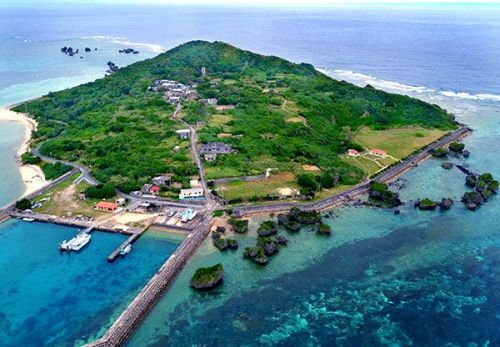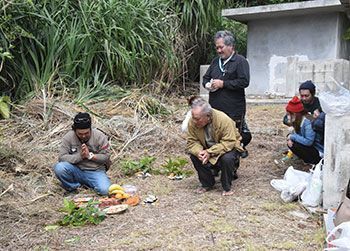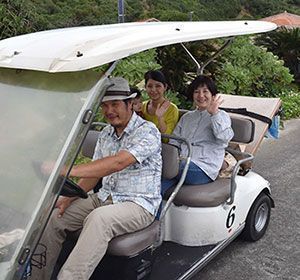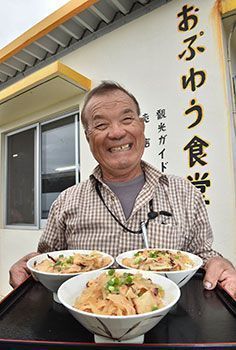Ogami Island, just 4 km from Miyako Island, a mysterious place protecting tradition

Ogami Island, located 4 km northeast of Miayko Island. With a population of 25 people in 15 households, it is the only island surrounding Miyako not connected by bridge. (Photograph taken from a small-sized drone)
February 27, 2017 Ryukyu Shimpo
(Story: Masaki Umeda; Photos: Futoshi Hanashiro, Masatoshi Moromizato)
Ogami Island is located around four kilometers northeast of Miyako Island. It is known as the “Island of Prayer,” best represented by the secret ritual Uyagan. The only of Miyako Island’s four surrounding islands not accessible by bridge, access is limited to a regular ferry that departs from Shimajiri Bay. Because of the secret ritual, up until now outside investigations and outside settlement on the island has been blocked.
Due to continuing population decline, the population is around 25 people, 1/6 of what it was at its peak in the 1950’s. All of this contributes to the islands air of mystery.
It is around a 15 minute boat ride to the island. There is only a single road connecting the port to the village. The houses along the road are adorned with nets and glass buoys, painting a scene of a tranquil fishing village. Almost all of the visitors take the one road from the port, arriving at “Pyutati” in around 10 minutes. The place is surrounded by the view of a beautiful, cobalt blue sea.
From the port, an incomplete road meant to circle the island stretches out in both directions. Construction began almost 35 years ago, but at some point along the way they met with a large stone that could not be broken up by their machinery, and this among other incidences led the road to go unfinished. At the time it was said on the island that they had, “made the god of nature angry.” But now it is generally considered that Ogami Island has a uniquely hard ground that could not be penetrated by machines.
While circling around the island on the road, you can enjoy looking for groups of large stones protruding from the water. In particular, there is a popular stone on the north side of the island that looks like a mushroom, which has been dubbed the, “Nocchi stone.” People who have seen the stone, characterized by its narrow base, say, “It is strange that it has not fallen over yet,” and that it was a little nerve-racking.
These rituals and prayers had been performed for a little shy of 60 years. This includes the observation of the famous Paantu. Among these rituals, the one the island residents hold most dear is Uyagan. Even now, for the Uyagan ceremony four times a year, a part of the island is restricted to everyone except the women who perform the ceremony.
While declining population threatens the continuation of these rituals, the island steadfastly protects their traditions, resisting the flow of time. This attitude is at the heart of the allure of Ogami Island.
(Translated by T&CT and Sam Grieb)
Refreshing smoked octopus
The specialty of Ogami Island is called kakidako. It is a dish made with smoked octopus born around the island. While it is well known throughout all of Miyako Island, few have ever laid eyes on it. The island’s only restaurant and guest house “Opoyu shokudo,” offers a kakidako-don for 800 yen. The marquee dish is smoked octopus and sautéed onions served over rice. It has a unique and refreshing flavor and texture. Restaurant owner Takagi Oura, 64, boasts, “It takes skill to popery smoke the octopus. The result is a flavor we pride ourselves on that can’t be had anywhere else.”
The island’s first lifestyle magazine, published January 28, “Upushi,” has a kakidako recipe printed inside. The first step is to rub the octopus with salt to remove the slipperiness. Then remove the organs, and smoke for half a day to a full day. From the magazine: “While it’s called ‘smoking,’ if there is too much smoke, it will be no good. It is important to dry the octopus slowly with the heat from the coals.” The octopus will shrink to anywhere from half to 1/3 of its original size. Since it already has the nuance of being a “teether,” kakidako is given to infants who are just beginning to grow teeth.
For generations, each family has kept octopus pots in the water just off the island’s coast. Oura himself goes out to catch octopus after business quiets down at the restaurant. Behind the restaurant, he has a constructed a separate building for smoking kakidako. Oura stresses, “If you burn the octopus, it will get bitter. You have to keep it in for a long time, without burning it. Experience is everything.” Smiling, he added, “Also, since this is the marquee menu item, we have to make sure we don’t run out.”

“Juurukunitsu” which means the 16th day, a ceremony held on January 16. Residents gather, burn incense and greet their ancestors.

Tourists travelling around the island in a cart

Takagi Oh’ura, holding his famous kakidako-don with a proud smile
Previous Article:MIyako Island coral reef dies due to high water temperatures
Next Article:Aircraft circle private property in Ginoza despite local appeals against use of nearby helipad
[Similar Articles]
- Tourists to be asked to pay 300 yen entrance fee to Taketomi Island to be used for environmental preservation
- First passengers of an around-the-islands-cruise depart from Naha Port
- Light rain amid rain-making rituals on Kohama Island
- Madama-michi Road from 16th century excavated around Shurei gate
- Habu snake caught on Miyako Island for the first time
 Webcam(Kokusai Street)
Webcam(Kokusai Street)


